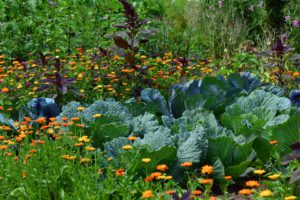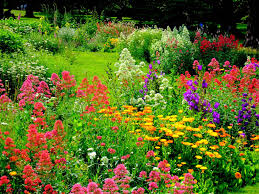Garden Plants That Complement Each Other

In this day and time, there are many approaches to gardening, each method brings along with it a set of rules or practices which will give us the success we are looking for. It is the goal of many gardeners whether as a beginner or one who has been in this field for a while, whether on residential or commercial projects not only to reap a good harvest but to contribute to the ecosystem by bringing balance.
In this article, however, we will be looking at another method of gardening that is so popular with its many benefits that is companion planting or choosing and grouping plants in a garden area that will complement each other
Companion plants
What are the benefits of this garden method?

- Encourages beneficial insects
- Increases crop yield
- Pollination
- Shade or Protection
- More variety of plants
- Aesthetics
- Being efficient in the use of garden space
- Supports Wildlife
- Helps in the reduction of weeds
- Soil improvement
Benefits of Companion Plants
Encouraging Beneficial Insects
1. The use of certain plants will attract beneficial insects, these beneficial insects will protect our garden plants by feeding on garden insect pests this method is known as biological control which is a great way to grow food crops without the use of harmful chemicals.
Increasing Crop Yield
2. Grouping plants together will ward off garden insect pests this will increase crop yield by protecting plants.
Pollination
3. The benefit of companion planting with plants that attract pollinators is that these pollinators will contribute to the yield of a good harvest.
Shade or Protection
4. The use of taller plants to help in filtering the sunlight for smaller more tender plants so they don’t scorch or burn is great in protecting these plant species.
More Plant selection
5. With companion planting, you have a greater variety of garden plants that can serve you in so many ways.
Aesthetics
6. A garden ought to create interest, one way this can happen is by companion planting. Can you imagine a garden that uses the same plant species throughout the plant design this would not be pleasing to the eyes, have you ever gone on a nature walk, what caused you to get excited or to have a restful feeling?
It was not only the blue skies and wildlife but the different species of plants with their varied shapes, colors, and sizes that were pleasing to your eyes. When designing a garden we should keep this in mind, I believe that nature is our greatest example.
Use of Space
7. We should seek to utilize every bit of space in our garden, companion planting can help us to achieve this. The size and shape of garden plants will help us in taking advantage of the garden space that is available to us.
Supports Wildlife
8. A great way to connect with nature is by attracting wildlife as you watch them in their natural habitat, attracting wildlife is a great way to bring balance to our ecosystem. Companion planting will help you in providing a home for wildlife. For more on wildlife gardening, refer to the category section of this. website.
Helps in the Reduction of Weeds
9. Weeds can become such an eyesore distracting from the beauty of any garden, not only that but weeds will encourage diseases and garden insect pests besides competing with your garden plants for water, sun, and nutrients.
Using smaller plants such as ground covers that grow near the soil level will help in the control of weeds.
Soil Improvement
10. Although there are many varies which determine a successful garden one thing is for sure that is the soil. Soil really does matter and what better way to improve your garden soil than by installing plants such as peas and beans which draw nitrogen from the atmosphere and adds it to the soil?
Some plants which can be grouped together to control garden pest
Companion Plant list
1. Lettuce, beans, cabbage, and onion.
2. Beans, mint, celery and snap beans.
3. Corn, peppers, squash, cucumbers, and pumpkin.
4. Potatoes, beets, carrots, cucumber, corn, celery, and Marigold.
5. Corn, celery, cauliflower, and strawberry.
6. Marigolds, golden Durante, ti-plants, and lantanas.
7. Corn, spinach, and swiss chard.
8. Chamomile, cabbage, melons, and onions
9. Peppers, corn, squash, cucumbers, and pumpkins.
10. Zinnias and cauliflowers.
11. Basil, parsley, and tomatoes.
12. Okra, radish, sunflowers, peas, beans, and corn
13. Oregano, grapes, broccoli, tomatoes, beans, squash.
14. Tomatoes, roses, chives, onion, carrots.
15. Celery, cabbage, beans, asparagus, tansy.
16. Coriander, basil, dill, marigold, parsley, and tomato.
17. Marigold, sage, dill, mint, celery, oregano, and beets.
18. Zucchini, legumes, peas, and beans.
19. Tomatoes, radish, eggplant, squash, peas, and corn.
20. Kale, celery, beans, dill, and onions.
The final word
The use of companion planting is a great way of helping to improve your garden and landscapes, this method is not new but is being used in many home gardens and many commercial projects. This may be the first time you have heard of this gardening method so go ahead gave it a try and experience the many benefits this garden type brings.
About the author
Norman loves being in the garden, both at home and for his job....
he is 'Natures Little helper' being outdoors, growing his vegetables and flowers from an early age.
Now having spent over 22 years in the profession he want to give some of his knowledge to others...
his vast array of hints and tips you will find scattered over this site will help you no end growing plants in your garden.

This was fun to read and it made me think about the companion planting I’ve used in the past. It was only ever just small patches in my garden. Can you tell me if it is possible to do companion planting with mostly flower plants? I don’t grow vegetables anymore and want to fill my beds with around the year seasonal hardy flowers and plants.
Your list of vegetable companion plants was very helpful. A terrific idea, especially to keep our bees happy and keep other pests down.
Lily 😊
Thanks a lot for your kind words, so happy to meet you. What I will do for you is to write an article on this for you God’s willing so be on the lookout. So happy to help and have a good day.
My father has this 13-hectare farm a few miles away from our house and although the farm is productive, it looks like he hasn’t utilized the farm to its full potential because of lack of knowledge about this companion planting. I will share or discuss this idea to him and I bet he will listen as he’s hungry for new ideas from young people who have studied in schools.
If this can be done with vegetable crops as you have listed here, can this be done also with fruit-bearing trees? Or, better yet, can you come up with a blog post listing the pairs of fruit-bearing trees for companion planting?
It will be so good to utilize this land to grow food crops who knows with much success he may be able to make a business out of this. At your request, I will write a blog God’s willing of fruit-bearing trees for companion planting just be on the lookout. Have a good day.
Companion gardening is nice and very useful, its effect in the plant the ecosystem makes it valuable. I’m actually not into it and I can’t say much about it but this article has given me a clear picture of what it looks like and how it can be done. I’ll give it a try and I know it’s going to be a great experience. Thanks for also sharing the list of plants that can be grounded together. This is very useful, I’ll check it out and I’ll definitely give you a reply as I make progress.
Dreajay it is a pleasure to help and I will be looking for your reply. If there is any other way I can help please let me know. All the best to you and have a good day.
I really like the idea of companion plants gardening and it’s so nice to hear of its lots of benefits. Encouraging beneficial insects is a very nice one and it’ll help the plants produce and grow healthily. I love the plants combination that you shared in this article for garden pest control, it’ll be of great help. I really wish I can go straight into this but I have so many gardening activities at hand but I’ll bookmark this page so that I can be able to reach this information at it’s time of need. I’ve learned a lot, thanks to you.
Again Wildecoll its a pleasure and I am wishing you all the best of success with your many gardening plans. Please let me know how it goes, all the best to you my friend.